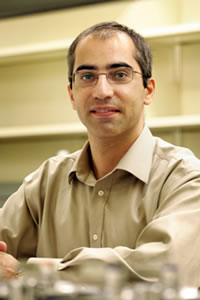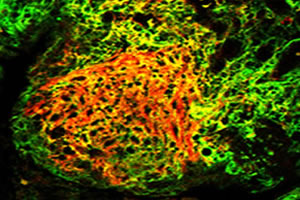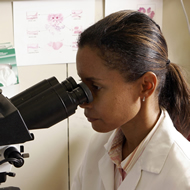
Environmental Factor, November 2008, National Institute of Environmental Health Sciences
Healing Process Found to Backfire in Lung Patients
By Robin Mackar
November 2008


A mechanism in the body that typically helps a person heal from an injury may actually be causing patients with idiopathic pulmonary fibrosis (IPF) to get worse, researchers at NIEHS and their collaborators have found.
"We identified a new mechanism that explains why some patients with IPF get more short of breath than others, in spite of similar levels of lung scarring," said Stavros Garantziotis, M.D., an NIEHS staff clinician and lead author on the new paper (http://www.ncbi.nlm.nih.gov/pubmed/18703791?ordinalpos=3&itool=EntrezSystem2.PEntrez.Pubmed.Pubmed_ResultsPanel.Pubmed_DefaultReportPanel.Pubmed_RVDocSum)![]() highlighted on the cover of the November 1 issue of the American Journal of Respiratory and Critical Care Medicine.
highlighted on the cover of the November 1 issue of the American Journal of Respiratory and Critical Care Medicine.
Idiopathic pulmonary fibrosis is an incurable lung disease that affects approximately 50,000 people in the United States. In IPF, the lung tissue becomes scarred and patients have difficulty breathing, often resulting in death. The cause is unknown, though genes as well as environmental factors, such as smoking and exposure to metal dust particles, are thought to raise the risk.
In healthy individuals, the body has a way of forming new blood vessels that can help heal an injury. For example, if you cut your finger, the body knows to deliver nutrients and cells to the injury site to promote wound healing. However, in patients with IPF, although there is a healing process that occurs, the researchers said the process backfires or is disrupted and may be doing the patients more harm than good. Garantziotis explained that this involves a blood protein called inter-alpha-trypsin inhibitor (IaI), which binds with a connective tissue molecule called hyaluronan to make new blood vessels.
In people without IPF, this produces a healing process in the lungs. But Garantziotis said something different happens in people with IPF.
"Instead of building healthy new tissue to heal the scarring in the lungs, patients with higher IaI levels develop vessels that are far away from where they should be, pushing the blood away from the lung and bypassing the area where the body gets its oxygen, thus causing more shortness of breath," Garantziotis explained. Patients with IPF may suffer from low oxygen levels and shortness of breath beyond the actual effects of lung scarring itself.
The researchers applied a true bench-to-bedside approach for this study. Starting with basic research findings from in vitro cell and experimental animal studies, they were then able to demonstrate, in patients with IPF, that higher IaI serum levels were associated with less ability to take up oxygen, thus worsening the patients' condition.
The researchers say there are at least two reasons why this study is important. First, it demonstrates for the first time the important role that a blood circulating protein plays in lung function. Secondly, it identifies a potential new therapeutic target for IPF.
In addition to the NIEHS, other collaborators on the paper include scientists affiliated with the Angiogenesis Core Facility, National Cancer Institute, Gaithersburg, Md.; Duke University Medical Center, Durham, N.C.; Vanderbilt University Medical Center, Nashville, Tenn.; Institute for Molecular Science of Medicine, Aichi Medical University, Aichi, Japan; National Jewish Medical and Research Center, Denver; and the National Heart, Lung, and Blood Institute, Bethesda, Md.
Citation: Garantziotis S, Zudaire E, Trempus CS, Hollingsworth JW, Jiang D, Lancaster LH, Richardson E, Zhuo L, Cuttitta F, Brown KK, Noble PW, Kimata K, Schwartz DA. (http://www.ncbi.nlm.nih.gov/pubmed/18703791?ordinalpos=3&itool=EntrezSystem2.PEntrez.Pubmed.Pubmed_ResultsPanel.Pubmed_DefaultReportPanel.Pubmed_RVDocSum) ![]() 2008. Serum Inter-{alpha}-Trypsin Inhibitor and Matrix Hyaluronan Promote Angiogenesis in Fibrotic Lung Injury. Am J Respir Crit Care Med 178(9):939-947.
2008. Serum Inter-{alpha}-Trypsin Inhibitor and Matrix Hyaluronan Promote Angiogenesis in Fibrotic Lung Injury. Am J Respir Crit Care Med 178(9):939-947.
(Robin Mackar is the News Director in the NIEHS Office of Communications and Public Liaison and a regular contributor to the Environmental Factor.)
"Study Finds Elevated ..." - previous story ![]()
![]() next story - "Superfund Study Detects......"
next story - "Superfund Study Detects......"
November 2008 Cover Page



